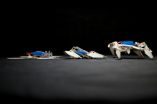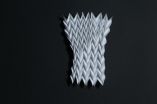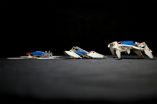(Press-News.org) This release is available in Japanese.
Inspired by the traditional Japanese art form of Origami or "folding paper," researchers have developed a way to coax flat sheets of composite materials to self-fold into complex robots that crawl and turn.
"We demonstrated this process by building a robot that folds itself and walks away without human assistance," said Sam Felton, a Ph.D. candidate at Harvard University's School of Engineering and Applied Sciences and the Wyss Institute for Biologically Inspired Engineering and the lead author of a new report in the 8 August issue of the journal Science .
In the experiment, the researchers' robot self-assembled from flat sheets of paper and shape memory polymers (which change shape when heated above 100˚ Celsius) into which they had embedded electronics. The flat composite transformed into a dynamic, functional machine in about four minutes. It then crawled away at a speed of about 5.4 centimeters or over 2 inches, per second, and it also turned—all without human help. No previous self-folding approach has yielded a machine that can function without additional outside assistance.
This new approach, which is both efficient and versatile, allows researchers to quickly produce complex robots that are scalable to different sizes and are also very strong for their weight, the new study reports.
For the last decade, the team that worked on this approach has been looking at ways to increase the complexity of robotic devices. They started by building folding-based devices at very small scales. Despite inherent design challenges ( i.e., the skills required to fold such complex geometries), they realized the value of continuing, and creating robots at bigger, more traditional robot scales.
"Folding allows you to avoid the 'nuts and bolts' assembly approaches typically used for robots or other complex electromechanical devices and it allows you to integrate components (e.g., electronics, sensors, actuators) while flat," said Rob Wood, the Charles River Professor of Engineering and Applied Sciences Core Faculty Member at Harvard University's Wyss Institute for Biologically Inspired Engineering and the study's senior author.
Felton added that "traditional manufacturing requires expensive machinery, and 3D printing is too slow for mass production, but planar composites can be rapidly built with inexpensive tools like laser cutters and etch tanks, and then folded into functional machines. Such manufacturing methods would be ideal for producing 100-1000 units."
"These robots are inexpensive and [their] layered composites can be built faster than equivalent 3-D printed structures," Felton continued.
The researchers, who collaborated with colleagues at the Massachusetts Institute of Technology, created their robot by using parts and materials that are readily available, such as a shape-memory polymer and self-folding hinges. The hinges feature embedded heating circuits that created the heat necessary to activate the folding. The placement of these hinges in the composite, and the order in which they are triggered create a fold pattern that determines the final shape of the 3-D structure, the study reports.
3-D design software that generated detailed crease patterns in the polymer material automated the folding process. It formed creases that became connected in cyclic folds, or a collection of creases.
"Cyclic folds are used by a software program called 'Origamizer' as building blocks to create any polyhedron," explained Felton. "We've discovered that we can [use this approach] to create a wide variety of structures and machines."
In this case, the stiffness and type of the folds raised the robot's body, which propelled the legs to angle downward.
Potential uses for these self-folding, functional machines include deployment or in a search-and-rescue scenarios where they could be activated to navigate small tunnels or spaces. "[They could be delivered] through a confined passageway, such as a collapsed building, after which they would assemble into their final form autonomously," said Marc Lavine, a senior editor at Science.
The fact that they could be shipped flat in large quantities, and then assembled once onsite, makes them especially valuable. Other examples of their use include deployment into space for various forms of exploration, IKEA-style furniture that assembles upon arrival, or for self-folding shelters that rapidly assemble in disaster zones.
Yet another promising application for this technology is rapid prototyping of new designs for tiny machines that are too small to be assembled by hand.
In a related report, Jesse Silverberg from Cornell University report how they, too, used origami-based engineering to design and build a new type of lightweight, ultra-tough programmable metamaterial. The researchers explain that metamaterials are constructed out of medium-sized building blocks that are bigger than atoms, but much smaller than the structures they are used to construct and that "by adding structure at this intermediate size, previously unobtainable properties can be engineered with ease."
The researchers studied a specific type of zigzag folding pattern that has been used to efficiently pack solar panels for space missions. They used the pattern to create folded sheets, and then devised a way to structurally alter the sheets so that they could control their mechanical properties. This would allow them to create metamaterials with desirable properties, such as strength or stiffness.
"When incorporated into more complex devices, these materials will enable on-the-fly transformation of mechanical function," explained Silverberg. "We envision combining these origami-inspired materials with computer-controlled actuators to build more complex machines, such as hardening shells, locked-in joints and deployable barriers; and ultimately, this transformer technology will revolutionize the way we think about materials, moving them beyond their current static form, and revealing more functionality than what originally meets the eye."
The team, led by Cornell University’s Itai Cohen, will present the research at the Sixth International Meeting on Origami in Science, Mathematics and Education, 10-13 August, in Tokyo, Japan.
INFORMATION:
A related Perspective by Zhong You from the University of Oxford in the United Kingdom discusses additional applications in the field of origami engineering.
Find the journal Science online:
Website: http://www.scienceonline.org
Facebook: http://www.facebook.com/AAAS.Science
Twitter: @sciencemagazine
YouTube: wwwAAASorg
Share on Twitter: .@sciencemagazine engineering study shows how origami-inspired pop-up #robots function on their own #AAAS
The American Association for the Advancement of Science (AAAS) is the world's largest general scientific society, and publisher of the journal, Science as well as Science Translational Medicine and Science Signaling . AAAS was founded in 1848, and includes some 261 affiliated societies and academies of science, serving 10 million individuals. Science has the largest paid circulation of any peer-reviewed general science journal in the world, with an estimated total readership of 1 million. The non-profit AAAS is open to all and fulfills its mission to "advance science and serve society" through initiatives in science policy; international programs; science education; and more. For the latest research news, log onto EurekAlert!, http://www.eurekalert.org, the premier science-news Web site, a service of AAAS.
Small, origami-inspired pop-up robots function autonomously
New self-folding method creates complex machines and allows rapid assembly
2014-08-07
ELSE PRESS RELEASES FROM THIS DATE:
Ocean's most oxygen-deprived zones to shrink under climate change
2014-08-07
As the complex story of climate change unfolds, many of the endings are grim. But there are exceptions. Predictions that the lowest-oxygen environments in the ocean would get worse may not come to pass. Instead, University of Washington research shows climate change, as it weakens the trade winds, could shrink the size of these extreme low-oxygen waters.
"The tropics should actually get better oxygenated as the climate warms up," said Curtis Deutsch, a UW associate professor of oceanography. He is lead author of the study published Aug. 8 in Science.
Warmer water contains ...
Water 'microhabitats' in oil show potential for extraterrestrial life, oil cleanup
2014-08-07
PULLMAN –An international team of researchers has found extremely small habitats that increase the potential for life on other planets while offering a way to clean up oil spills on our own.
Looking at samples from the world's largest natural asphalt lake, they found active microbes in droplets as small as a microliter, which is about 1/50th of a drop of water.
"We saw a huge diversity of bacteria and archaea," said Dirk Schulze-Makuch, a professor in Washington State University's School of the Environment and the only U.S. researcher on the team. "That's why we speak ...
Orally delivered compounds selectively modify RNA splicing, prevent deficits in SMA models
2014-08-07
Today the journal Science published results of a preclinical study demonstrating that treatment with orally available RNA splicing modifiers of the SMN2 gene starting early after birth is preventing deficits in a mouse model of Spinal Muscular Atrophy (SMA). Scientists from Roche Pharma Research and Early Development (pRED), PTC Therapeutics, Inc., the SMA Foundation, the University of Southern California and Harvard University collaborated to demonstrate that continuous treatment of SMA mice with these compounds increased life span, normalized body weight and prevented ...
Study reveals dynamics of microbes and nitrate
2014-08-07
Human tampering with global carbon balances has received massive public attention because of its effects on global warming, but we pay less attention to another set of chemical processes we are similarly disrupting: human input to the nitrogen cycle. Unfortunately, the story of nitrogen transformations in the biosphere is also less understood.
In modern times, humans developed the technology to turn nitrogen gas in the atmosphere into a biologically available form to be used as fertilizer. Before this, bio-available or "fixed" nitrogen was only created sparingly by natural ...
Origami could lead to exotic materials, tiny transformers
2014-08-07
ITHACA, N.Y. – Embracing the pleats, creases and tucks of the Japanese art of decorative paper folding, Cornell University researchers are uncovering how origami principles could lead to exotic materials, soft robots and even tiny transformers.
Publishing online in the journal Science Aug. 8, an interdisciplinary team led by Cornell's Itai Cohen, associate professor of physics, and graduate student Jesse Silverberg have discovered how to use a well-known origami folding pattern called the Miura-ori to control fundamental physical properties of any thin sheet of material.
Video, ...
Step closer to birth of the sun
2014-08-07
Researchers are a step closer to understanding the birth of the sun.
Published in Science, the team led by Dr Maria Lugaro and Professor Alexander Heger, from Monash University, have investigated the solar system's prehistoric phase and the events that led to the birth of the sun.
Dr Lugaro, from the Monash Centre for Astrophysics, said the team used radioactivity to date the last time that heavy elements such as gold, silver, platinum, lead and rare-earth elements were added to the solar system matter by the stars that produced them.
"Using heavy radioactive nuclei ...
Finding the genetic culprits that drive antibiotic resistance
2014-08-07
Researchers have developed a powerful new tool to identify genetic changes in disease-causing bacteria that are responsible for antibiotic resistance. The results from this technique could be used in clinics within the next decade to decide on the most effective treatments for diseases such as pneumonia and meningitis.
The team looked at the genome of Streptococcus pneumoniae, a bacterial species that causes 1.6 million deaths worldwide each year. In the most detailed research of its kind, scientists used a genome-wide association study (GWAS) to locate single-letter ...
Learning from origami to design new materials
2014-08-07
AMHERST, Mass. -- A challenge increasingly important to physicists and materials scientists in recent years has been how to design controllable new materials that exhibit desired physical properties rather than relying on those properties to emerge naturally, says University of Massachusetts Amherst physicist Christian Santangelo.
Now he and physicist Arthur Evans and polymer scientist Ryan Hayward at UMass Amherst, with others at Cornell and Western New England University, are using origami-based folding methods for "tuning" the fundamental physical properties of any ...
Robot folds itself up and walks away
2014-08-07
A team of engineers used little more than paper and Shrinky dinks™ – the classic children's toy that shrinks when heated – to build a robot that assembles itself into a complex shape in four minutes flat, and crawls away without any human intervention. The advance, described in Science, demonstrates the potential to quickly and cheaply build sophisticated machines that interact with the environment, and to automate much of the design and assembly process. The method draws inspiration from self-assembly in nature, such as the way linear sequences of amino acids fold into ...
Origami robot folds itself up, crawls away
2014-08-07
For years, a team of researchers at MIT and Harvard University has been working on origami robots — reconfigurable robots that would be able to fold themselves into arbitrary shapes.
In the August 7 issue of Science, they report their latest milestone: a robot, made almost entirely from parts produced by a laser cutter, that folds itself up and crawls away as soon as batteries are attached to it.
"The exciting thing here is that you create this device that has computation embedded in the flat, printed version," says Daniela Rus, the Andrew and Erna Viterbi Professor ...
LAST 30 PRESS RELEASES:
Tracing the quick synthesis of an industrially important catalyst
New software sheds light on cancer’s hidden genetic networks
UT Health San Antonio awarded $3 million in CPRIT grants to bolster cancer research and prevention efforts in South Texas
Third symposium spotlights global challenge of new contaminants in China’s fight against pollution
From straw to soil harmony: International team reveals how biochar supercharges carbon-smart farming
Myeloma: How AI is redrawing the map of cancer care
Manhattan E. Charurat, Ph.D., MHS invested as the Homer and Martha Gudelsky Distinguished Professor in Medicine at the University of Maryland School of Medicine
Insilico Medicine’s Pharma.AI Q4 Winter Launch Recap: Revolutionizing drug discovery with cutting-edge AI innovations, accelerating the path to pharmaceutical superintelligence
Nanoplastics have diet-dependent impacts on digestive system health
Brain neuron death occurs throughout life and increases with age, a natural human protein drug may halt neuron death in Alzheimer’s disease
SPIE and CLP announce the recipients of the 2025 Advanced Photonics Young Innovator Award
Lessons from the Caldor Fire’s Christmas Valley ‘Miracle’
Ant societies rose by trading individual protection for collective power
Research reveals how ancient viral DNA shapes early embryonic development
A molecular gatekeeper that controls protein synthesis
New ‘cloaking device’ concept to shield sensitive tech from magnetic fields
Researchers show impact of mountain building and climate change on alpine biodiversity
Study models the transition from Neanderthals to modern humans in Europe
University of Phoenix College of Doctoral Studies releases white paper on AI-driven skilling to reduce burnout and restore worker autonomy
AIs fail at the game of visual “telephone”
The levers for a sustainable food system
Potential changes in US homelessness by ending federal support for housing first programs
Vulnerability of large language models to prompt injection when providing medical advice
Researchers develop new system for high-energy-density, long-life, multi-electron transfer bromine-based flow batteries
Ending federal support for housing first programs could increase U.S. homelessness by 5% in one year, new JAMA study finds
New research uncovers molecular ‘safety switch’ shielding cancers from immune attack
Bacteria resisting viral infection can still sink carbon to ocean floor
Younger biological age may increase depression risk in older women during COVID-19
Bharat Innovates 2026 National Basecamp Showcases India’s Most Promising Deep-Tech Ventures
Here’s what determines whether your income level rises or falls
[Press-News.org] Small, origami-inspired pop-up robots function autonomouslyNew self-folding method creates complex machines and allows rapid assembly




